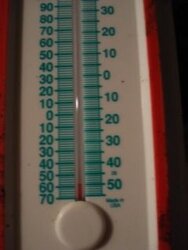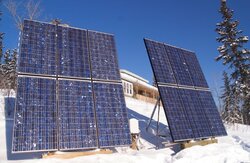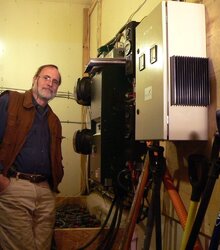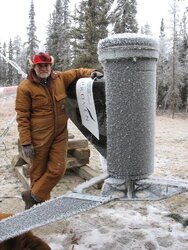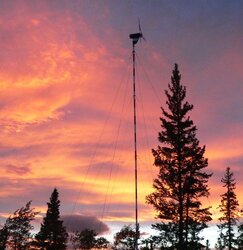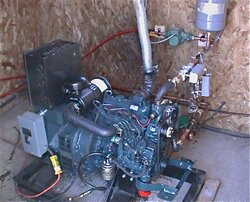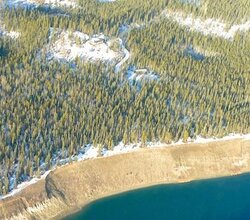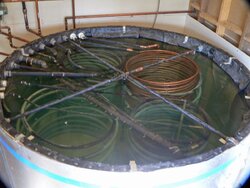Just discovered the forum, and have been enjoying reading through the postings from the past several years.
I have been benefitting from a wood gasification boiler for 9 winters--a much beloved Tarm Solo Plus 40. However, two years ago I completed a guest suite above the garage/mechanical building, effectively adding 1200 sq.ft. to our heated living space (now a total of slightly more than 3000 sq.ft.).
The Tarm is able to keep up with the heat needs, but only just, and not able on cold days (-20C and below) to add enough BTUs to the heatsink to prevent the oil boiler from needing to kick in between going to bed and getting up, or going to work and returning in the evening. So I am looking at replacing the Tarm. (I should say that I have been very happy with it and it is still working great in every respect. My only complaint has been that it smokes when firing up and loading. Creosote is almost non-existent.)
For a variety of reasons, I am down to deciding between an Econoburn EBW200 or 300 or the Frohling FHG-L50. But I would love to benefit from the wisdom on the forum around some of my thinking.
As I see things, part of my problem with the Tarm is the size of the firebox (5.4 cu. ft.). If the firebox was twice as big, the BTU output would keep up (even if just barely) with the heat loads. My reasoning is that, even at -40, if there is wood in the boiler, the 850 gallon heatsink temp is not going down, and is typically gaining some. (Please correct me if I am mistaken in my reasoning.)
The Econoburn EBW200 has a firebox volume of 8.1 cu.ft.. The Frohling FHG-L50 has 7.4 cu.ft. Given that I do not like raising my heatsink above 165F, my guess is that the burn control features of the Frohling would allow me to get maximum BTUs out of my load of wood, but as a straight line transfer as opposed the bell curve of the Econonburn. (Though to be fair, the Econoburn also controls its burn via temperature sensing.)
There are other considerations as well. The Econoburn needs an 8" chimney and the Frohling needs a 6" chimney--which is what I currently have. As well, living off-grid as I do, power consumption is an issue. The Econoburn has a 175W fan at 110v, which is 1.6 amps. The Frohling draws 180W at 240v, which is .75 amps.
FYI, we do not have hardwood in this part of the world. I burn spruce and pine, with some poplar in the shoulder seasons (it generates a lot of ash, but there is always lots of standing dead on the property to clean up).
Anything that I am missing or should be thinking about?
Thanks for sharing your wisdom!
Barrett
I have been benefitting from a wood gasification boiler for 9 winters--a much beloved Tarm Solo Plus 40. However, two years ago I completed a guest suite above the garage/mechanical building, effectively adding 1200 sq.ft. to our heated living space (now a total of slightly more than 3000 sq.ft.).
The Tarm is able to keep up with the heat needs, but only just, and not able on cold days (-20C and below) to add enough BTUs to the heatsink to prevent the oil boiler from needing to kick in between going to bed and getting up, or going to work and returning in the evening. So I am looking at replacing the Tarm. (I should say that I have been very happy with it and it is still working great in every respect. My only complaint has been that it smokes when firing up and loading. Creosote is almost non-existent.)
For a variety of reasons, I am down to deciding between an Econoburn EBW200 or 300 or the Frohling FHG-L50. But I would love to benefit from the wisdom on the forum around some of my thinking.
As I see things, part of my problem with the Tarm is the size of the firebox (5.4 cu. ft.). If the firebox was twice as big, the BTU output would keep up (even if just barely) with the heat loads. My reasoning is that, even at -40, if there is wood in the boiler, the 850 gallon heatsink temp is not going down, and is typically gaining some. (Please correct me if I am mistaken in my reasoning.)
The Econoburn EBW200 has a firebox volume of 8.1 cu.ft.. The Frohling FHG-L50 has 7.4 cu.ft. Given that I do not like raising my heatsink above 165F, my guess is that the burn control features of the Frohling would allow me to get maximum BTUs out of my load of wood, but as a straight line transfer as opposed the bell curve of the Econonburn. (Though to be fair, the Econoburn also controls its burn via temperature sensing.)
There are other considerations as well. The Econoburn needs an 8" chimney and the Frohling needs a 6" chimney--which is what I currently have. As well, living off-grid as I do, power consumption is an issue. The Econoburn has a 175W fan at 110v, which is 1.6 amps. The Frohling draws 180W at 240v, which is .75 amps.
FYI, we do not have hardwood in this part of the world. I burn spruce and pine, with some poplar in the shoulder seasons (it generates a lot of ash, but there is always lots of standing dead on the property to clean up).
Anything that I am missing or should be thinking about?
Thanks for sharing your wisdom!
Barrett


